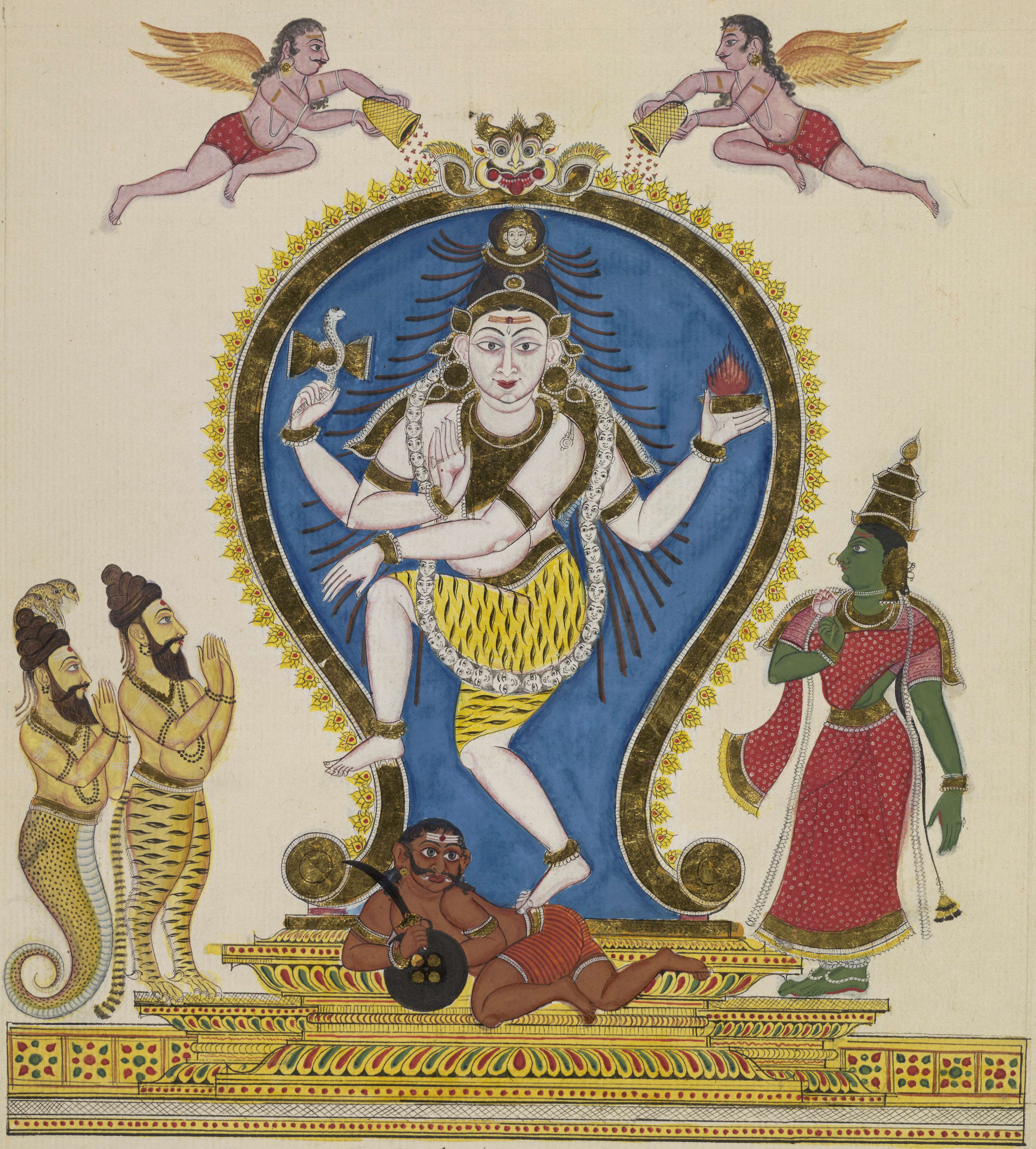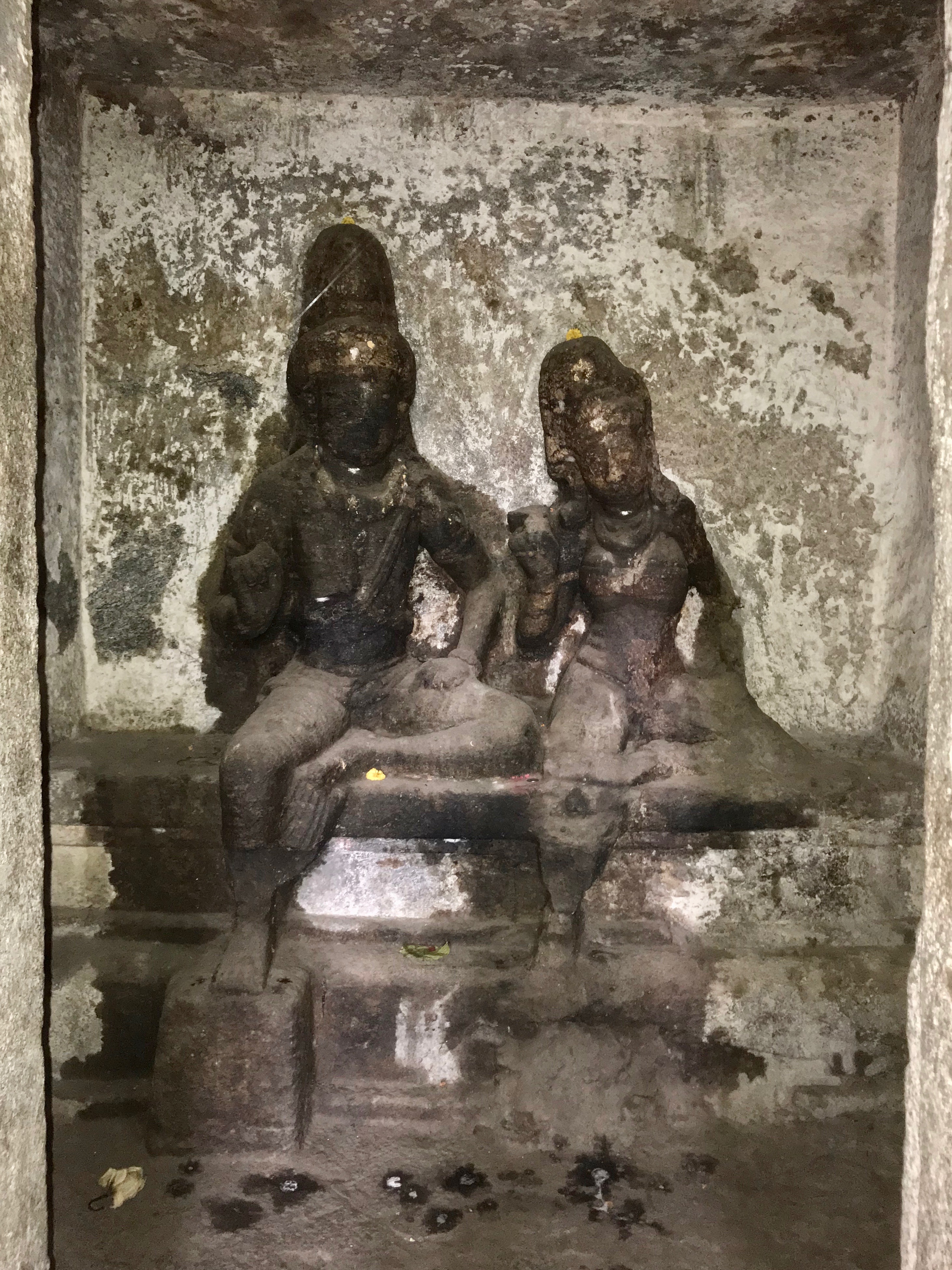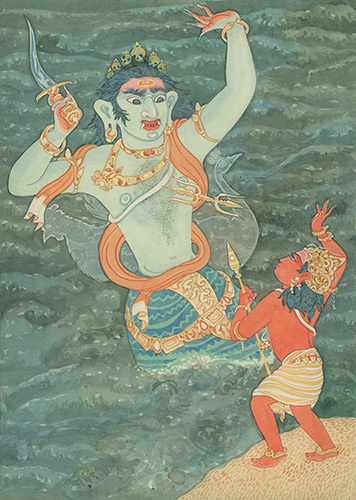|
Arangulanathar Temple
Arangulanathar Temple is a Shiva temple in Thiruvarangulam neighbourhood of Pudukkottai district of Tamil Nadu, India. This temple is also called as 'Haratheerthiswarar temple'. The main deity in this temple is Arangulanathar and the goddess is Brahadhambal (Periyanayaki). There is a mandap in this temple with 100 pillars. This temple is one of the Tevaram Vaippu Sthalams mentioned in one of Sambandar's patika. Location Arangulanathar temple is located with the coordinates of () at Thiruvarangulam. Sub deities Vishnu, Saraswati, Sitrambalam udaiyar, Nataraja, Dakshinamurti with musical instrument veena, Chandikeswarar, Porpanai Ganesha, Shanmuganathar with His consorts Valli and Devasena, Appar, Sambandar, Sundarar, Manikkavacakar Manikkavacakar was a 3rd-century Tamil saint and poet who wrote '' Thiruvasagam and Thirukkovaiyar'', books of Shaiva hymns. Tamil scholars and researchers share that he was a minister to the Pandya king Nedunjeliyan II (3rd Century CE) ... [...More Info...] [...Related Items...] OR: [Wikipedia] [Google] [Baidu] |
Pudukkottai District
Pudukkottai District is one of the List of districts of Tamil Nadu, 38 districts of Tamil Nadu state in southern India. The city of Pudukkottai is the district headquarters. It is also known colloquially as ''Pudhugai.'' The city is also known as Thondaman dynasty, Thondaiman Pudukkottai. Pudukkottai district is bounded on the northeast and east by Thanjavur District, on the southeast by the Palk Strait, on the southwest by Ramanathapuram District, Ramanathapuram and Sivaganga District, Sivaganga districts, and on the west and northwest by Tiruchirapalli, Tiruchirapalli District. As of 2011, the district had a population of 1,618,345 with a sex-ratio of 1,015 females for every 1,000 males. The district has an area of 4,663 km2 with a coastline of 42 km. The district lies between 78° 25' and 79° 15' east longitude and between 9° 50' and 10° 40' of the north latitude. Organisation On 14 January 1975, Pudukkottai was organised as a separate district comprising the f ... [...More Info...] [...Related Items...] OR: [Wikipedia] [Google] [Baidu] |
Nataraja
Nataraja (/ n̪əʈəɾɑd͡ʒᵊ/ ,, ; , ''Naṭarājar'' Telugu: నటరాజు,''Naṭarāju''), also known as Adalvallan (), is a depiction of Shiva, one of the main deities in Hinduism, as the divine cosmic dancer. His dance is called the tandava.''Encyclopædia Britannica'' (2015) The pose and artwork are described in many Hindu texts such as the ''Tevaram'' and '' Thiruvasagam'' in Tamil and the ''Amshumadagama'' and ''Uttarakamika agama'' in Sanskrit and the Grantha texts. The dance ''murti'' is featured in all major Hindu temples of Shaivism, and is a well-known sculptural symbol in India and popularly used as a symbol of Indian culture, as one of the finest illustrations of Hindu art. This form is also referred to as Kuththan (), Sabesan (), and Ambalavanan () in various Tamil texts. The sculpture is symbolic of Shiva as the lord of dance and dramatic arts, with its style and proportions made according to Hindu texts on arts. Tamil devotional texts such as ... [...More Info...] [...Related Items...] OR: [Wikipedia] [Google] [Baidu] |
Nayanars
The Nayanars (or Nayanmars; , and later 'teachers of Shiva') were a group of 63 Tamils, Tamil Hindu saints living during the 6th to 8th centuries CE who were devoted to the Hindu god Shiva. Along with the Alvars, their contemporaries who were devoted to Vishnu, they influenced the Bhakti movement in Middle kingdoms of India#The Deccan plateau and South, early medieval South India. The names of the Nayanars were first compiled by Sundarar. The list was expanded by Nambiyandar Nambi during his compilation of material by the poets for the ''Tirumurai'' collection, and would include Sundarar himself and Sundarar's parents. The Nalvar () are the three foremost Nayanars Appar, Sundarar, Sambandar along with Manikkavasagar, Manikkavacakar. History The list of the Nayanars was initially compiled by Sundarar (Sundararmurthi). In his poem ''Tiruthonda Thogai'' he sings, in eleven verses, the names of the Nayanar saints up to Karaikkal Ammaiyar, and refers to himself as "the servant of ser ... [...More Info...] [...Related Items...] OR: [Wikipedia] [Google] [Baidu] |
Manikkavacakar
Manikkavacakar was a 3rd-century Tamil saint and poet who wrote '' Thiruvasagam and Thirukkovaiyar'', books of Shaiva hymns. Tamil scholars and researchers share that he was a minister to the Pandya king Nedunjeliyan II (3rd Century CE) and lived in Madurai (or) he was a minister to the Pandya king Arikesari (6th Century CE ). He is revered as one of the Nalvar (''"group of four"'' in Tamil), a set of four prominent Tamil saints alongside Appar, Sundarar and Sambandar. The other three contributed to the first seven volumes (Tevaram) of the twelve-volume Saivite work Tirumurai, the key devotional text of Shaiva Siddhanta. Manikkavacakar's ''Thiruvasagam'' and Thirukkovaiyar form the eighth volume. These eight volumes are considered to be the ''Tamil Vedas'' by the Shaivites, and the four saints are revered as ''Samaya Kuravar'' (''religious preceptors'') His works are celebrated for their poetic expression of the anguish of being separated from God, and the joy of God-experie ... [...More Info...] [...Related Items...] OR: [Wikipedia] [Google] [Baidu] |
Sundarar
Sundarar (), also referred to as Chuntarar, Chuntaramurtti, Nampi Aruran or Tampiran Tolan, was an eighth-century poet-saint of Tamil Shaiva Siddhanta tradition of Hinduism. He is among the Tevaram trio, and one of the most prominent Nayanars, the Shaiva bhakti (devotional) poets of Tamil Nadu. His hymns form the seventh volume of the ''Tirumurai called Thiruppattu'', the twelve-volume compendium of Shaiva Siddhanta. His songs are considered the most musical in ''Tirumurai'' in Tamil language. His life and his hymns in the Tevaram are broadly grouped in four stages. First, his cancelled arranged marriage through the intervention of Shiva in the form of a mad petitioner and his conversion into a Shaiva devotee. Second, his double marriage to temple dancers Paravai and Cankali with their stay together in Tiruvarur. Third, his blindness and then return of his sight. Finally, his reflections on wealth and material goods. Names Sundarar is referred to by many names. Sundarar (Cunta ... [...More Info...] [...Related Items...] OR: [Wikipedia] [Google] [Baidu] |
Sambandar
Sambandar (Tamil language, Tamil: சம்பந்தர், Romanization, romanized: ''Campantar''), also referred to as Thirugnana Sambandar (Tamil language, Tamil: திருஞானசம்பந்தர், Romanization, romanized: ''Tiruñāṉacampantar''), was a Shaivism, Shaiva poet-saint of Tamil Nadu who lived sometime in the 7th century CE. According to the Tamil Shaiva tradition, he composed an of 16,000 hymns in complex meters, of which 383 (384) hymns with 4,181 stanzas have survived. These narrate an intense loving devotion (''bhakti'') to the Hindu god Shiva. Sambandar merged with the divine effulgence when he was sixteen years of age. The surviving compositions of the poet-saint are preserved in the first three volumes of the ''Tirumurai called'' Thirukkadik kaappu, and provide a part of the philosophical foundation of Shaiva Siddhanta. He is one of the most prominent of the sixty-three Nayanars, Tamil people, Tamil Shaiva Bhakti movement, bhakti saint ... [...More Info...] [...Related Items...] OR: [Wikipedia] [Google] [Baidu] |
Appar
Appar (), also referred to as Tirunavukkaracar () or Navukkarasar, was a seventh-century Tamil Shaiva poet-saint. Born in a peasant Shaiva family, raised as an orphan by his sister, he lived about 80 years and is generally placed sometime between 570 and 650 CE.Zvelebil 1974, p. 95 Appar composed 4,900 devotional hymns to the god Shiva, out of which 313 have survived and are now canonized as the 4th to 6th volumes of ''Tirumurai''. One of the most prominent of the sixty-three revered Nayanars, he was an older contemporary of Sambandar. His images are found and revered in Tamil Shiva temples. His characteristic iconography in temples show him carrying a farmer's small hoe – a gardening tool and weed puller. Names Appar is also known as Tirunavukkaracar (''lit.'' "King of the Tongue, Lord of Language"). His birth-name was Marulneekkiyar. He was renamed Dharmasenar while he studied and later served as the head of a Jain monastery. After he returned to Shaivism and began composi ... [...More Info...] [...Related Items...] OR: [Wikipedia] [Google] [Baidu] |
Devasena
Devasena (, , ) is the Hindu goddess of aspirations, and the consort of the war god Kartikeya (Murugan). She is also known as Devayanai, Deivanai, and Deivayanai in Tamil texts. Her name is also spelled as Teyvanai or Tevayanai (). Devasena is described as the daughter of the ''Prajapati'' Daksha in the ''Mahabharata'', while some Sanskrit scriptures consider her as the daughter of Indra, the king of the devas (gods), and his wife Shachi. In the Tamil iteration of the Skanda Purana, she is portrayed as the daughter of the god Vishnu, who is later adopted by Indra. She is betrothed to Kartikeya by Indra, when he becomes the commander-in-chief of the devas. In Tamil accounts, Devasena is generally depicted as an antithesis of Valli, her sister-wife; together they complete the deity. Devasena is generally depicted with Murugan, and is often also accompanied by Valli. In Tamil Nadu, Devasena does not enjoy independent worship, but is venerated as Murugan's consort in most of ... [...More Info...] [...Related Items...] OR: [Wikipedia] [Google] [Baidu] |
Valli
Valli () is a devi, Hindu goddess, and the second consort of the deity Murugan. An incarnation of the goddess Sundaravalli, daughter of Vishnu, Valli is born on earth as the daughter of a chieftain, leading a life of a huntress. Murugan, the god of war, eventually woos and weds her, according to Tamil mythology, Tamil folklore. Both of their legends originate from the mountain region also known as Sangam landscape, Kurunji in Tamilakam. Her sister, Devasena, Amritavalli (Devasena), also succeeds in marrying Murugan as the adopted daughter of Indra, making them sister-wives. Nomenclature ''Vaḷḷi'' is used to refer to many Village deities of South India, local or Grāmadevatā, Village gods in Tamil Nadu and Kerala in India and by the Rodiya and Vedda peoples of Sri Lanka. Vaḷḷi is also known as ''Pongi'' at Vallimalai in Vellore district, Vellore, Tamil Nadu, and the pond from which she drew water to quench the thirst of Murugan is still there. This pond, though in an o ... [...More Info...] [...Related Items...] OR: [Wikipedia] [Google] [Baidu] |
Kartikeya
Kartikeya (/Sanskrit phonology, kɑɾt̪ɪkejə/; ), also known as Skanda (Sanskrit phonology, /skən̪d̪ə/), Subrahmanya (/Sanskrit phonology, sʊbɾəɦməɲjə/, /ɕʊ-/), Shanmukha (Sanskrit phonology, /ɕɑnmʊkʰə/) and Murugan (/Sanskrit phonology, mʊɾʊgən/), is the Hinduism, Hindu List of war deities, god of war. He is generally described as the son of the deities Shiva and Parvati and the brother of Ganesha. Kartikeya has been an important deity in the Indian subcontinent since Vedic period, ancient times. Mentions of Skanda in the Sanskrit literature data back to fifth century BCE and the mythology relating to Kartikeya became widespread in North India around the second century BCE. Archaeological evidence from the first century CE and earlier shows an association of his iconography with Agni, the Hindu god of fire, indicating that Kartikeya was a significant deity in early Hinduism. He is hailed as the "favoured god of the Tamils", and the tutelary dei ... [...More Info...] [...Related Items...] OR: [Wikipedia] [Google] [Baidu] |
Ganesha
Ganesha or Ganesh (, , ), also known as Ganapati, Vinayaka and Pillaiyar, is one of the best-known and most worshipped Deva (Hinduism), deities in the Hindu deities, Hindu pantheon and is the Supreme God in the Ganapatya sect. His depictions are found throughout India. Hindu denominations worship him regardless of affiliations. Devotion to Ganesha is widely diffused and extends Ganesha in world religions, to Jains and Buddhists and beyond India. Although Ganesha has many attributes, he is readily identified by his Asiatic Elephant, elephant head and four arms. He is widely revered, more specifically, as the remover of obstacles and bringer of good luck; the patron of The arts, arts and Science, sciences; and the Deva (Hinduism), deva of intellect and wisdom. As the god of beginnings, he is honoured at the start of rites and ceremonies. Ganesha is also invoked during writing sessions as a patron of letters and learning., Vigna means obstacles Nasha means destroy. These ideas ar ... [...More Info...] [...Related Items...] OR: [Wikipedia] [Google] [Baidu] |
Dakshinamurti
Dakshinamurti () is an aspect of the Hindu god Shiva as a guru (teacher). He is regarded to be the personification of the supreme or the ultimate awareness, understanding, and knowledge. Dakshinamurti represents Shiva as a teacher of yoga, music, and wisdom, offering an exposition of the ''Shastras''. He is worshipped as the god of wisdom and meditation. Meaning Dakshinamurti literally means 'one who is facing south ()' in Sanskrit. According to another school of thought 'Dakshinya' means Karuna in Sanskrit or kindness (benevolence). So this manifestation of Shiva is a benevolent teacher who accords wisdom to seekers of salvation. In most of the Shiva temples, the stone image of Dakshinamurti is installed, facing south, on the southern circumambulatory path around the sanctum sanctorum. Depiction In his aspect as Jnana Dakshinamurti, Shiva is generally shown with four arms. He is depicted seated under a banyan tree, facing the south. Shiva is seated upon a deer-throne a ... [...More Info...] [...Related Items...] OR: [Wikipedia] [Google] [Baidu] |





